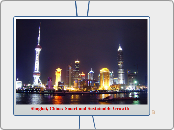Shaghai, China: Smart and Sustainable Growth
Over 700 years old, Shanghai was once considered the financial center of Asia. Currently, plans to make the city into a world trading, financial, economic, and shipping capital by the year 2020. The pace at which the city is undergoing urbanization is one of the fastest in the world. All over the city cranes can be found erecting new skyscrapers. Also, new suburban areas are being built to help the city expand. Shanghai's position in China allows it to continue to grow in trade, helping it expand its economy, and in turn making the pace of urbanization here one of the fastest in the world. Sadly, as a result of this, many people have been evicted from their homes. Overall, 3.7 million people have been evicted from their homes in China, and the majority of these occurred at Shanghai. Shanghai has utilized a variety of resources to help prepare for its future in becoming one of the largest metropolitan areas on earth.
http://www.npr.org/templates/story/story.php?storyId=6610882
Future Sustainable Growth
Shanghai will experience expansive growth over the next couple of decades, primarily across three sectors.
Real Estate Values and Business
Shanghai is the epicenter of China’s growth and housing prices are still relatively low. However, with China’s economy growing 9.5% a year many experts predict that prices and land values could soar higher than prices in Manhattan. This has huge implications for business. Wealthy investment firms will own the expensive land, creating luxury apartments and soaring office towers that will boom the downtown area. The Xintiandi is a good example of a luxury development that has already begun to become a prominent example of the future of Shanghai if land values soar.
http://www.time.com/time/magazine/article/0,9171,1050189,00.html
Shanghai's Role as a Seaport
Experts predict Shanghai seeing a yearly increase of 10% in activity from it’s sea ports over the next few years, primarily because of China’s increasing political ties with the external world and a booming international export market. However, China will have to find a way to be able to keep up with the increased capacity of it’s exports and this growth could be hindered by a lack of coordination between China’s east coast harbors. It’s nearby rival, Hong Kong, is Shanghai’s “rival” in seaport operations.
http://www.forbes.com/2008/03/19/cities-population-pollution-innovation08-cx_tvr_0319futurecities_slide_10.html?partner=udn
Population and Infrastructure
Shanghai currently has a population near or above 15 million, ranking it among the world’s most populous mega cities. Looking into the future, those numbers see solid increases. Forbes recently reported it’s new population projections for 2025, where Shanghai will rank in the top 10 in the world at 19.4 million. This means that in the next 17 years, over 4 million more people are expected to move into the city of Shanghai. Providing the infrastructure to facilitate this boom will be very important. Smart growth techniques (such as denser units closer to the city center or the process of urban renewal) to be able to facilitate the increased demand (on roads, retail, housing) will be crucial for economic development. High density units such as the 1,614 foot tall Shanghai World Financial Center or the upcoming White Magnolia Plaza (1,048 ft.) are a good start to this.
Contrary to the argument above, a few experts have said the population could actually see a net decrease due to a high death rate to birth rate ratio. So the future of the population remains unclear to some.
http://www.chinadaily.com.cn/bizchina/2008-03/22/content_6557837.htm
http://www.redorbit.com/news/display?id=135485&source=r_science
Role of the Environment
Shanghai’s environment plays a very large role in the city’s ability to sustain growth. Although the city has traditionally been behind in its environmental awareness compared to other large cities, public awareness of the environment is growing and a number of environmental protection projects are being initiated. The growing demand for exported energy is also forcing Shanghai to invest in alternative power supplies that will help it sustain through the future.
Energy Use
Shanghai’s energy consumption has been growing about 6-8% annually, with the growth of electricity demand at over 10% per year. Shanghai has very limited local energy resources and relies heavily on imported electricity, oil, coal, and natural gas. Industrial and commercial energy users now have to report their consumption, so that that city can reach its goal to save nearly 1.3 million tons of standard coal and reduce its energy consumption by 40 percent between 2005 and 2010. The city has also completed its initial goal to create 5G of wind power and is well on its way to the final goal of 30GW.
http://www.windpowershanghai.com/en/
http://www.chinadaily.com.cn/china/2007-03/08/content_822295.htm
http://www.osti.gov/energycitations/product.biblio.jsp?osti_id=827574
Geographic Advantages
Almost all of Shanghai’s 2,401 sq miles of land is flat, with an average elevation of 13 ft. This flat land allows for easy construction and expansion. The city also has an array of rivers, canals, and lakes that account for roughly 11% of the city’s territory. These rich water sources help with the city’s transportation and economic needs. Shanghai is bordered by the East China Sea on the east and Hangzhou bay on the south. The city also has a very central location on China’s coastline making Shanghai an excellent sea and river port, boasting easy access to the vast hinterland.
http://www.shanghai.gov.cn/shanghai/node17256/node17432/node17434/index.html
A Sustainable and Growing Economy
Shanghai has been successful at sustaining healthy economic growth. This is because it is among the top megacities in finance and trade, as well as manufacturing and technology. It is also the leading port city in China. The city contributes 11 percent of China’s total income. Shanghai alone contributes 1/12 of China’s total industrial output value. It holds 1/6 of China’s port cargo handling volume, 1/4 of China’s total exports, and 1/8 of China’s financial revenue. In 2003 the economy in Shanghai had double digit growth for the 12th consecutive year. The average person in Shanghai makes a salary of $4,910 a year, compared to the average person in China that earns less than $1000 a year.
http://www.sfisc.com/en/jjfz.asp
http://www.buyusa.gov/china/en/shanghai.html
Manufacturing and Technology
Shanghai’s manufacturing industry accounts for around 48 percent of the city’s economy. Two major automobile manufacturers located in Shanghai are General Motors and Volkswagen. It is the second largest iron and steel producer. It is also known for being a major refining center for copper, lead, and zinc. In 2003 Shanghai’s Gross Domestic Product (GDP) reached 622.8 billion RMB which is equivalent to 75.31 billion in U.S dollars.
http://www.lbma.org.uk/docs/conf2004/1c.zheng_LBMAConf2004.pdf
http://www.pbs.org/frontlineworld/stories/china/facts.html#04
Finance and Trade
Known as a world class business center, the Shanghai Stock Exchange is located in Luijiazui financial district in Pudong, which is China’s largest stock exchange. The Shanghai World Finance Center is the second tallest building in the world, and home to many international banking and commercial businesses. The U.S has some 4,700 projects invested in Shanghai. The American Chamber of Commerce is located there. It is the largest in Asia and attracts some 15,000 long term American residents.
http://www.bjreview.com.cn/exclusive/txt/2009-03/10/content_184206.htm
Subtopic
Improving Infrastructure
Renewal of Waste and Resources
Renewal of waste and resources in Shanghai has led this city to have the largest sewer treatment plant in China. These facilities process 1.7 million tons of waste each day. In 2008, Shanghai aimed to reduce the air and water pollutants by 5 percent. In order to do this officials have stated that they are going to either close or upgrade most of these facilities to amend the quality of the city's environment. The plans for renewal of waste and resources are aimed to be around 2010. One goal announced by the Shanghai Urban Construction Investment and Development Corp. is the development of the largest silt treatment plant that will remove the silt in sewage, treat it so it van be reused again in land fertilization. Another goal that is aimed around 2010 is to reduce the sulfur dioxide levels and overall chemical oxygen demand discharge to 259,000 tons.
http://w1.siemens.com/en/megacities/shanghai.htm
Construction Reform
Construction-reform within Shanghai is an event that is occurring each day. The city is tearing down old buildings and rebuilding them with high-rise buildings that are improving the sustainability and growth of the city. The facilitation of new buildings being developed ,especially in private sectors, is aimed to help contribute to the economic growth and stability in Shanghai. The North Bund is a section in the city of Shanghai which includes an old Jewish ghetto. City officials made an announcement of their plans to reform the old North Bund area into renowned art by the 21st century. This renowned art would include “a modern business and residential district with skyscrapers, apartment buildings, cruise ship docks and even an enormous Ferris wheel.”
http://www.bernama.com/bernama/v5/newsworld.php?id=403811
http://www.nytimes.com/2004/05/31/arts/salvaging-jewish-heritage-in-china-block-by-block.html?scp=5&sq=urban%20renewal%20in%20Shanghai&st=cse
Transportation
Transportation in Shanghai is rapidly growing and has many ways different ways in order to travel about the city. Shanghai is the only city in China that has two international airports. Another mode of transportation in Shanghai is the public transit bus system which has over 1,100 buses on route each day. Traveling by boat is Shanghai is very cheap but this particular traveling process is considered the mode of transportation that takes the longest time. Shanghai developments and sustainable growth a leadinreg the city to become one of the major financial centers and shipping hubs by the year 2020.
http://www.asianinfo.org/asianinfo/shanghai/shanghai_transportation.htm
http://www.shanghaidaily.com/sp/article/2009/200903/20090326/article_395519.htm
http://www.ineedhotel.com/shanghai/tour/trans.html









